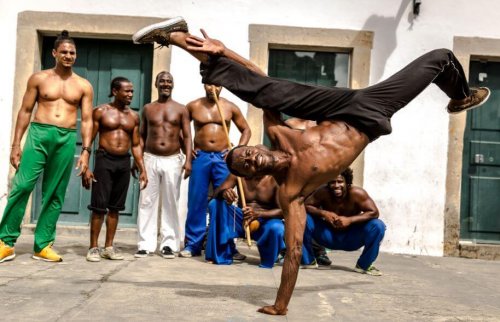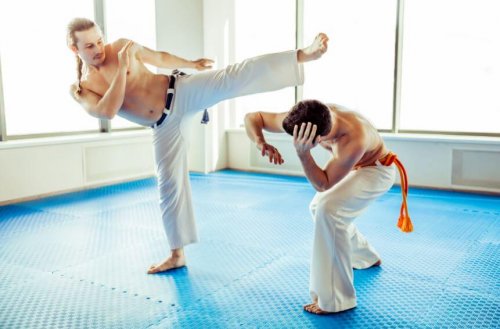What is Capoeira: dance, art or sport?

Capoeira became a trend several decades ago and even today many people still practice it. It has been defined as a dance discipline that originates from Brazil, but this definition is still not entirely correct.
What is Capoeira?
According to an editor of a renowned Brazilian magazine:
“Capoeira combines the balance and the flexibility of acrobatics, the grace and strength of dance, the speed and wit of wrestling, and all this, to the rhythm of music.”
Given the controversy of Capoeira being a combination of dance and martial arts, you can imagine that the moves are beyond ordinary. Although it originated in Brazil, it also has an African descent. It’s based on movements that the African people created to celebrate their gods and use in other martial arts.

And although today we find people who practice Capoeira with different music genres, the original style, (the one adopted by Brazilian indigenous people in the 16th century), is Capoeira with berimbau, a traditional African instrument.
Capoeira as a dance
Yes, you may also believe that Capoeira is a dance. Its movements must go with the rhythm of the music and in fact, musicians and Capoeiristas come together in a circle to start ‘dancing’. Two Capoeiristas ‘fight’ as the others sing, clap and play music.
This martial art, sport or whatever you want to call it, is so tightly linked to music that you can consider it dance as well.
Capoeira as a martial art
This is the main definition of Capoeira and the aim behind its creation. Its movements are inspired by other ancient martial arts. The tradition says that it was the slaves who, in the quest of staying in shape to withstand humiliations and oppression, practiced the movements in secret.
The main movements emerged from a courtship dance used by young African men in Angola, so for the people who used to buy slaves, it wasn’t strange to see them make those movements.
Just like that, it spread among slaves as a way of training, which they later used to fight against their “owners” for their freedom. That’s the reason why the most prominent moves are kicks and sweeps at ground level.

Capoeira as a sport
And of course, we can’t deny that Capoeira is a sport. The bodies of those who regularly practice it, are proof of how intensely the muscles work.
Its semi-static moves work not only the external muscles but the internal as well, which translates into more noticeable and long-lasting muscle tone. Since the movements involve the whole body, this martial art allows you to work all areas, without neglecting a single muscle.
In addition, as with any other sport, practicing it has many health benefits. Some of these are:
- Improved balance.
- Increased sense of rhythm.
- Helps improve posture.
- Prevents muscle atrophy, as well as joint problems.
- Faster metabolism.
- Improved circulation and heart health.
Any activity that keeps your body moving is beneficial to your health, and Capoeira is no exception. Although at first, it may not seem like a very active sport-art-dance, your body works from the inside.
If you want to try this martial art, look for a professional to help you, since a wrong move could lead to injury. And of course, remember to always have fun and go with the music!
Capoeira became a trend several decades ago and even today many people still practice it. It has been defined as a dance discipline that originates from Brazil, but this definition is still not entirely correct.
What is Capoeira?
According to an editor of a renowned Brazilian magazine:
“Capoeira combines the balance and the flexibility of acrobatics, the grace and strength of dance, the speed and wit of wrestling, and all this, to the rhythm of music.”
Given the controversy of Capoeira being a combination of dance and martial arts, you can imagine that the moves are beyond ordinary. Although it originated in Brazil, it also has an African descent. It’s based on movements that the African people created to celebrate their gods and use in other martial arts.

And although today we find people who practice Capoeira with different music genres, the original style, (the one adopted by Brazilian indigenous people in the 16th century), is Capoeira with berimbau, a traditional African instrument.
Capoeira as a dance
Yes, you may also believe that Capoeira is a dance. Its movements must go with the rhythm of the music and in fact, musicians and Capoeiristas come together in a circle to start ‘dancing’. Two Capoeiristas ‘fight’ as the others sing, clap and play music.
This martial art, sport or whatever you want to call it, is so tightly linked to music that you can consider it dance as well.
Capoeira as a martial art
This is the main definition of Capoeira and the aim behind its creation. Its movements are inspired by other ancient martial arts. The tradition says that it was the slaves who, in the quest of staying in shape to withstand humiliations and oppression, practiced the movements in secret.
The main movements emerged from a courtship dance used by young African men in Angola, so for the people who used to buy slaves, it wasn’t strange to see them make those movements.
Just like that, it spread among slaves as a way of training, which they later used to fight against their “owners” for their freedom. That’s the reason why the most prominent moves are kicks and sweeps at ground level.

Capoeira as a sport
And of course, we can’t deny that Capoeira is a sport. The bodies of those who regularly practice it, are proof of how intensely the muscles work.
Its semi-static moves work not only the external muscles but the internal as well, which translates into more noticeable and long-lasting muscle tone. Since the movements involve the whole body, this martial art allows you to work all areas, without neglecting a single muscle.
In addition, as with any other sport, practicing it has many health benefits. Some of these are:
- Improved balance.
- Increased sense of rhythm.
- Helps improve posture.
- Prevents muscle atrophy, as well as joint problems.
- Faster metabolism.
- Improved circulation and heart health.
Any activity that keeps your body moving is beneficial to your health, and Capoeira is no exception. Although at first, it may not seem like a very active sport-art-dance, your body works from the inside.
If you want to try this martial art, look for a professional to help you, since a wrong move could lead to injury. And of course, remember to always have fun and go with the music!
All cited sources were thoroughly reviewed by our team to ensure their quality, reliability, currency, and validity. The bibliography of this article was considered reliable and of academic or scientific accuracy.
- Assunção MR. Ringue ou academia? A emergência dos estilos modernos da capoeira e seu contexto global [Capoeira circle or sports academy? The emergence of modern styles of capoeira and their global context]. Hist Cienc Saude Manguinhos. 2014 Jan-Mar;21(1):135-49. Portuguese.
- Campos JWS, Dibai-Filho AV, Cordeiro MEC, Mariano ER, Souza SAR. Disability and pain in capoeira practitioners. Rev Assoc Med Bras (1992). 2021 Nov;67(11):1692-1695.
- Moreira SR, Teixeira-Araujo AA, Dos Santos AO, Simões HG. Ten weeks of capoeira progressive training improved cardiovascular parameters in male practitioners. J Sports Med Phys Fitness. 2017 Mar;57(3):289-298.
- Moreira SR, Teixeira-Araujo AA, Numata Filho ES, Moraes MR, Simões HG. Psychophysiological characterization of different capoeira performances in experienced individuals: A randomized controlled trial. PLoS One. 2018 Nov 15;13(11):e0207276.
- Moreira SR, Ii ACO, Armstrong A. Capoeira: hypothesis on health rehabilitation and quality-of-life maintenance. Rev Assoc Med Bras (1992). 2022 Nov 28;68(11):1530-1536.
This text is provided for informational purposes only and does not replace consultation with a professional. If in doubt, consult your specialist.








